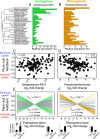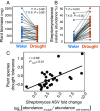Assembly and ecological function of the root microbiome across angiosperm plant species
- PMID: 29358405
- PMCID: PMC5819437
- DOI: 10.1073/pnas.1717617115
Assembly and ecological function of the root microbiome across angiosperm plant species
Abstract
Across plants and animals, host-associated microbial communities play fundamental roles in host nutrition, development, and immunity. The factors that shape host-microbiome interactions are poorly understood, yet essential for understanding the evolution and ecology of these symbioses. Plant roots assemble two distinct microbial compartments from surrounding soil: the rhizosphere (microbes surrounding roots) and the endosphere (microbes within roots). Root-associated microbes were key for the evolution of land plants and underlie fundamental ecosystem processes. However, it is largely unknown how plant evolution has shaped root microbial communities, and in turn, how these microbes affect plant ecology, such as the ability to mitigate biotic and abiotic stressors. Here we show that variation among 30 angiosperm species, which have diverged for up to 140 million years, affects root bacterial diversity and composition. Greater similarity in root microbiomes between hosts leads to negative effects on plant performance through soil feedback, with specific microbial taxa in the endosphere and rhizosphere potentially affecting competitive interactions among plant species. Drought also shifts the composition of root microbiomes, most notably by increasing the relative abundance of the Actinobacteria. However, this drought response varies across host plant species, and host-specific changes in the relative abundance of endosphere Streptomyces are associated with host drought tolerance. Our results emphasize the causes of variation in root microbiomes and their ecological importance for plant performance in response to biotic and abiotic stressors.
Keywords: host microbial ecology; plant drought; plant microbiome; plant–soil feedback; root microbiome.
Conflict of interest statement
The authors declare no conflict of interest.
Figures





References
Publication types
MeSH terms
Substances
Associated data
LinkOut - more resources
Full Text Sources
Other Literature Sources

